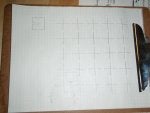I have an idea for a king bed made from a frame of 15in plywood cubes, sandwiching 3 plywood "floortimber" type crossmembers, with two rows of these cubes on either side, and a row of cubes at the foot of the bed.
I'm trying to think about the joinery to be used on the 15in plywood boxes. I imagined finger joints, but research indicates this is a bad idea. I would like to optimize for ease of technique for a carpenter with limited tools, and allowing for extra tolerance, while maximizing structural integrity.
Alternatively, I could send this out to be laser cut.
What joints should I use to make the boxes?
Alternatively, this easily be less expensive for me to outsource this to an appropriate shop.
Thanks!
I'm trying to think about the joinery to be used on the 15in plywood boxes. I imagined finger joints, but research indicates this is a bad idea. I would like to optimize for ease of technique for a carpenter with limited tools, and allowing for extra tolerance, while maximizing structural integrity.
Alternatively, I could send this out to be laser cut.
What joints should I use to make the boxes?
Alternatively, this easily be less expensive for me to outsource this to an appropriate shop.
Thanks!





